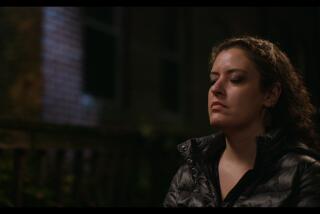Healer Calls on ‘Curing Angels’ to Guide Hands
SAN DIEGO — The patient was ready for surgery.
Her name was Hortensia Caballero, and her beauty was evident even as she lay on her back with her eyes closed. Her legs were covered by a sheet; her blouse had been pulled up to expose her belly.
The air in the examining room filled with a sweet, heavy scent from a burning candle as Sara Vasquez--better known as Sarita--soaked a cotton ball with rubbing alcohol and swabbed the crook of Caballero’s arm with it. Then, as if she was holding an invisible syringe, Sarita made a pumping motion with her thumb and mimicked an injection of anesthetic into the patient’s arm.
“God help me,” Sarita said softly, and the psychic surgery began.
Caballero, 29, had complained of persistent pain in her abdomen. Instead of seeing a doctor, however, the pretty young Tijuana resident had consulted Sarita, a psychic healer with an office in San Diego’s Barrio Logan.
Sarita had diagnosed a tumor in Caballero’s belly. Now she was going to remove it.
Entire Procedure An Act
The entire procedure was performed without instruments, like a pantomime of surgery in a hospital. Everything--the incision, the removal of the tumor, the sutures and even a blood transfusion at the end--was acted out as if it was taking place in some invisible realm.
And Sarita had time to talk about what she was doing as she worked. “In my mind, I’m asking the curing angels to come in the name of God and guide my curing hands,” she explained at one point.
At the beginning of the 15-minute operation, Sarita’s 34-year-old son, Miguel Ruiz Macias, held Caballero’s head in his hands and whispered softly to her. But toward the end he raised one cupped hand up toward the ceiling--”To receive energy and channel it” to Caballero, he said afterward.
To finish the psychic surgery, Sarita spread olive oil on Caballero’s belly and worked it in with her strong brown hands. Then the healer offered another prayer: “Thank you, Lord, for helping her. And to the angels of light who came to her--thanks for your mercy.”
“Now it’s all done,” she said, and helped Caballero to a sitting position on the examining table.
Folk healers--often known as curanderos --belong to a long tradition in Hispanic culture. They trace their origins to Indian shamans who used herbs and prayers--and sometimes powerful hallucinogenic drugs--to communicate with both good and evil spirits.
Low-Cost Alternative
Despite the advances of modern medicine, belief in the powers of curanderos has persisted in many Latin American countries, including Mexico and Peru. And as Latinos have immigrated to the United States, so have curanderos .
Some people with injuries or diseases consult curanderos as a kind of low-cost alternative to a medical examination. Others believe that while a broken arm or an infection might require a visit to a doctor, such things as depression, a philandering husband or a house plagued by evil spirits can only be remedied by a curandero .
In San Diego, no curandero is better known than Sarita, partly because, unlike most curanderos , she shares her experiences, beliefs and healing methods openly with her followers and the media. She has been instructed to do so by her spiritual guides, she explained.
Sarita, 77, was born in Guadalajara and worked for many years as a seamstress in Mexico City and Tijuana. While living in Tijuana during the early 1960s, she became ill and was told by doctors that she needed an operation for gallstones and a heart murmur. Instead, she consulted a psychic healer in Tijuana, and when the woman healed her with psychic surgery, Sarita became the woman’s apprentice.
After moving to Mexico City to further study psychic healing, Sarita moved to Barrio Logan in 1970 and opened her own practice in a sparsely furnished office on Logan Avenue. The office--known as Templo de Nueva Vida, or Temple of New Life--includes three examining rooms as well as a large front room where services and classes are held.
Ruiz, Sarita’s son, who says he has a medical degree from the University of Mexico, has assisted his mother for the last several years. (Because Sarita speaks only Spanish, Ruiz often translates for her, as he did when she was interviewed at her office recently.)
Ruiz also teaches a weekly class in philosophy and meditation at the Logan Avenue office. Sarita’s husband, Jose Luis Ruiz, performs “spiritual cleansings” to counter evil curses that affect some patients. But Sarita’s specialty is psychic surgery.
Says She Can Visualize Tumor
“When I undertake a healing--for example, with someone who has a brain tumor--I can visualize and feel (in my mind) where the tumor is,” said Sarita. “I can put my hands on it.
“I can also see a light--like a star--that means that the person will benefit from the healing” procedure. Then she knows, she said, that she can proceed with the surgery.
She uses rubbing alcohol and olive oil in the operations because, she explained, she once received a message from her guiding spirits to do so.
Many times one operation is enough to cure the patient, but sometimes two or three are required, Sarita noted. She advises her patients to rest and to avoid such things as alcohol, cigarettes and fried foods for a few days after surgery, and to eat such things as fish, chicken, vegetables and fruits. Her patients are typically asked to return to have their “stitches” removed five days after the operation.
Sometimes people come to her who are beyond help, Sarita said. “When the person is going to die, I see a beautiful woman, like an angel of the dead, beside him,” she said. “I call her the white child--she has long blonde hair--and when I see her I know I can do nothing,” she said.
“Last week a priest brought a man who had many tumors. I saw the energy of the dead beside him, and when he left I told the priest outside, ‘I’m sorry, but this person will die. It’s time for the transition.’ ”
A few days later, Sarita said, the priest called her to say that the man had indeed died.
Even so, those with cancer are sometimes given a pill that contains a powder made from animals, including skunks and snakes, according to Ruiz. The only AIDS patient Sarita has seen, a young man who came to her last year, was also told to take the pills. “They helped him live a little longer but he eventually died,” Ruiz said.
More than half of Sarita’s patients are Latinos, according to Ruiz. But only about 5% come for surgery, and they typically “donate” $50 for the procedure, he added. Two to three percent need to have evil curses broken or demons removed from themselves or their houses.
Such curses are brought about by witches--who are simply people who have learned to use spiritual power for negative purposes, according to Sarita. The curse might take the form of a disease or an emotional disorder.
Negative Energy ‘Extracted’
The cure is a desalojo , a “cleansing” procedure in which incense or aromatic herbs are burned in fire, accompanied by prayers. Often an egg or a lemon, symbolizing an embryo, is also passed over the affected person to “extract” the negative energy.
“It’s a ceremony that is thousands of years old. Indian shamans did it to defeat the bad vibrations that can affect every person,” said Sarita’s husband, Jose Luis Ruiz, who performs most of the desalojos at Sarita’s office.
“The person must believe it will work,” he added. “If they don’t have faith, I can’t help them.” A donation of $10 covers the cost of most desalojos.
Less drastic cleansings often are performed to help solve marital problems or to help someone overcome drug abuse. “Many people (who come to see Sarita) think they have a problem with witchcraft but it’s really an emotional problem,” said Ruiz. “In fact, most people come for emotional problems.”
It’s cheaper than going to a psychiatrist, he said. The patients “have the small ceremony here with the egg and they feel much better.”
Douglas Sharon, director of the San Diego Museum of Man, has studied Peruvian curanderos off and on for 17 years, and pointed out that they fulfill a role akin to a combination counselor-doctor-priest.
“These people are basically grass-roots counselors or social workers,” said Sharon. “In a more traditional society, a lot of things we call emotional problems are dressed in the garb of witchcraft.”
Sharon, who watched Sarita operate on Hortensia Caballero, said the “surgery” was “a classic example . . . of what I believe is a worldwide shamanistic tradition of removing a pathogen that is invisible to the patient. The shaman can see it but the patient can’t, because the patient doesn’t have ‘psychic sight.’ ”
Ruiz emphasized that the ability to heal the sick is only part of a larger spirituality that Sarita and her followers are striving toward. “We are looking for freedom . . . to become a new kind of human being,” he explained. “And in the way we look for that we gain spiritual powers and can become healers. But it’s just secondary.
“We believe that the end of a cycle is here and that humanity has to be transformed to another kind of person, more positive, more free.”
Sarita talks cheerfully of encounters with extraterrestrials and astral trips to other planets. She also plans to build a crystal pyramid on a mountain near Dulzura that will become a center for learning and healing, and is actively soliciting donations for the project.
By embracing such “New Age” concepts, Sarita differs from the more traditional folk healers that Sharon has studied in Peru. But even among curanderos in Peru, “Western occult and spiritual traditions have been creeping in” Sharon said, “and it’s quite common for curanderos in Peru to talk about extraterrestrials, too.”
He believes that such concepts are part of an effort to update folk traditions and communicate with modern and increasingly educated patients--in other words, to create a new style of shamanism for the ‘80s.
“The traditional beliefs are adapting to the current, popular way of trying to deal with the spiritual realm, and flying saucers are very much a part of that,” said Sharon.
Many health workers have complained that patients who consult curanderos could be postponing badly needed medical attention, and Sharon said that “in my experience in Peru, that can sometimes be true. But I’ve also found that often by the time someone goes to a curandero, they’ve already been to every doctor they can think of. Some people take both doctors and curanderos seriously.”
One patient of Sarita’s, 54-year-old Antonio Ortega of San Diego, said he was in the hospital with a spinal virus four years ago when his wife, Juana, visited Sarita and asked for her help. Ortega credits Sarita’s subsequent visit to his bedside for bringing him out of a coma and making him well enough to resume his life. Now he and his wife regularly attend services and classes at Sarita’s Logan Avenue office.
“I think what happened to me was a sign from God, and now I have changed my life completely--given up cigarettes and drinking,” Ortega said.
Hortensia Caballero said she first came to Sarita earlier this year after visiting a doctor for a leg injury suffered in a fall down a stairway. Fourteen injections of penicillin had failed to make her leg feel better, she said. “But after I saw Sarita, I felt better. I trust her a lot--more than a doctor,” Caballero said with a nervous laugh.
“When the medical doctors can do nothing, then we do spiritual surgery working with our spiritual guides,” Sarita said. “But we know it is God that does the healing. God gives us all the power and it is a marvelous thing . . . because there are a lot of people who need to be healed.”
More to Read
Sign up for Essential California
The most important California stories and recommendations in your inbox every morning.
You may occasionally receive promotional content from the Los Angeles Times.









